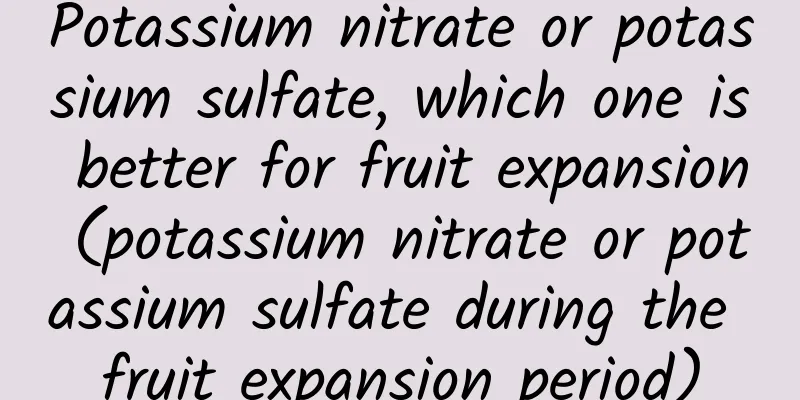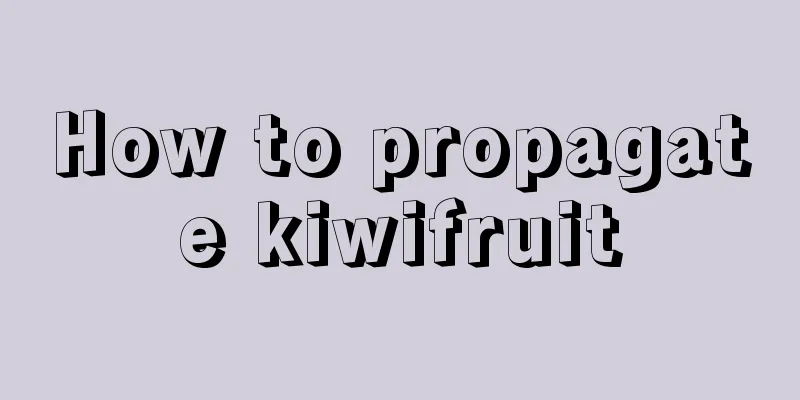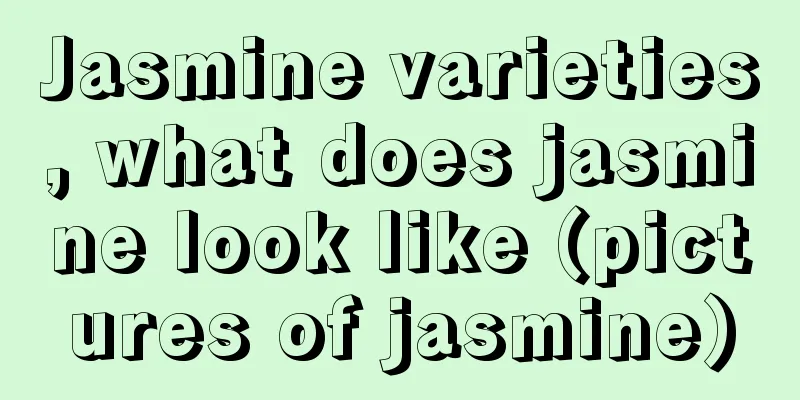Potassium nitrate or potassium sulfate, which one is better for fruit expansion (potassium nitrate or potassium sulfate during the fruit expansion period)

|
Potassium nitrate and potassium sulfate are both fertilizers with high potassium content, but potassium nitrate is a binary compound fertilizer, while potassium sulfate is the main type of potassium fertilizer, containing potassium and sulfur. Whether it is potassium nitrate or potassium sulfate, it is sold in most agricultural supply distribution stores in various places. You can also buy it online. It shouldn’t be too difficult to buy it, right? Potassium has a great influence on the expansion, coloring, taste, etc. of the fruit. It can promote the absorption of nitrogen, which is beneficial to the expansion and coloring of the fruit. Because potassium can be recycled, potassium-deficient plants do not show symptoms of potassium deficiency immediately, but only appear to grow slower. Most symptoms of potassium deficiency are not obvious until the middle and late stages of crop growth. Therefore, potassium application to crops requires early application, preferably basal application and early topdressing. You can apply potassium nitrate or potassium sulfate during the fruit expansion period of crops, but for colored fruits such as apples and peaches, I recommend applying potassium sulfate, especially potassium nitrate should be applied with caution during the color change period of the fruit . This is mainly because: 1. Potassium nitrate contains nitrogen, and topdressing during the color change period affects color developmentPotassium nitrate is a nitrogen-potassium compound fertilizer containing about 13% nitrogen and about 46% potassium (K2O). Potassium can transport nitrogen and promote fruit expansion, but nitrogen is not conducive to fruit coloring. Applying excessive potassium nitrate fertilizer during the fruit expansion and coloring period will affect the color of the fruit and easily cause the fruit to turn green again. Potassium nitrate is easily soluble in water, is a quick-acting fertilizer, and is neutral. Because the nitrogen in potassium nitrate is nitrate nitrogen, which is easily lost with water, potassium nitrate is generally not suitable for use as a base fertilizer, especially in paddy fields. It is generally used as a topdressing fertilizer. For fruit trees such as apples, grapes, peaches, and cherries, which require beautiful fruit color as a selling point, it is best not to apply potassium nitrate fertilizer during the coloring period of the fruit. However, for root crops such as potatoes, ginger, taro, and sweet potatoes, topdressing can be applied in the middle and late stages of their growth, with better results. When applying potassium nitrate to these crops, it is important to apply other nitrogen and phosphorus fertilizers in combination to improve fertilizer efficiency. Potassium nitrate can also be sprayed on leaves at a concentration of 0.6%-1%. It can be sprayed on leaves during the fruit expansion period. It is recommended to use it with caution in the middle and late stages . 2. Potassium sulfate is the main potassium fertilizer and can be applied throughout the processPotassium sulfate is the main type of potash fertilizer, with a potassium content (K2O) of 48%-52%, generally 50%. Pure potassium sulfate is white, easily soluble in water, and is a fast-acting potassium fertilizer with weak hygroscopicity and is not easy to clump. The main reason is that potassium sulfate does not contain nitrogen and will not affect the color change of fruits. In particular, it does not contain chlorine, and has better effects on chlorine-sensitive crops and cruciferous crops that require sulfur. Potassium sulfate is an acidic fertilizer. If used continuously for many years in acidic soil, it may increase soil acidity. If used continuously for many years in alkaline soil, it may cause soil compaction. Whether it is grain crops or economic crops such as fruits and vegetables, potassium sulfate can be used as base fertilizer, topdressing fertilizer, seed fertilizer and foliar fertilizer. When applying potassium sulfate to crops such as sweet potatoes, potatoes, and fruit trees, it is best to apply it deeply and in a concentrated manner in the root-dense area to facilitate absorption and utilization by the root system. Potassium sulfate can be applied at any time during the fruit expansion period, but it can be applied in combination with appropriate amounts of nitrogen and phosphorus fertilizers in the early stages to fully exert the fertilizer effect . In acidic soil, it can be applied together with phosphate rock powder and lime to improve the utilization rate of phosphorus and prevent the increase of soil acidity. Potassium sulfate should not be applied to paddy fields. 3. The price of potassium nitrate is higher than that of potassium sulfateThe price of potassium nitrate is much higher than that of potassium sulfate. Although potassium nitrate can be used in the early stage of fruit expansion, if the soil has sufficient nitrogen fertilizer, I think it is more cost-effective to use potassium sulfate, and it can also be applied during the color change period . 【 Summarize 】 In the early stage of fruit expansion, you can apply potassium nitrate or potassium sulfate, but after the fruit changes color, it is recommended that you apply potassium sulfate . In terms of input, potassium sulfate is less than potassium nitrate. Therefore, in the fruit expansion period, I think it is better to use potassium sulfate. |
<<: What is the best month to plant fennel (sowing time and management methods of fennel)
Recommend
Taboos on cultivating purse flowers in winter
Wind and Light The purse flower has very high req...
How to whiten your skin with Mirabilis jalapa
1. Which part can be whitened? Many people only k...
Small pumpkin planting time and method cultivation management technology
Pumpkin planting time Small pumpkins are suitable...
Okra Planting Time and Method
Okra, a delicious and nutritious vegetable , has ...
The efficacy and function of spinach
The efficacy and function of spinach Dietary valu...
What are the cultivation methods and precautions of umbrella bamboo?
Umbrella bamboo cultivation method Umbrella bambo...
The legendary agave
Agave Flower Language The flower language of Agav...
Why doesn't the osmanthus tree bloom?
1. Unsuitable soil It grows more suitably in sand...
When is the best time to transplant Sophora japonica trees? (Sophora japonica tree transplanting time and method)
The best place to transplant a Sophora japonica t...
Is the iron tree easy to grow?
1. Is it easy to raise? The iron tree is actually...
How to prune the branches of Vinca roseus
When to prune vinca Vinca can be pruned in summer...
Home lily vase flower arrangement
Flower Arrangement Material Needless to say, lily...
How long does the camellia bloom? How to water, fertilize and manage it?
1. Opening hours my country spans a wide area fro...
How to propagate Jade Dew by cuttings, and how long does it take for the cuttings to take root?
1. How to propagate Jade Dew by cuttings 1. Picki...
Cultivation methods and precautions of yellow bract arrowroot
soil Well-drained, aerated soil with plenty of nu...









